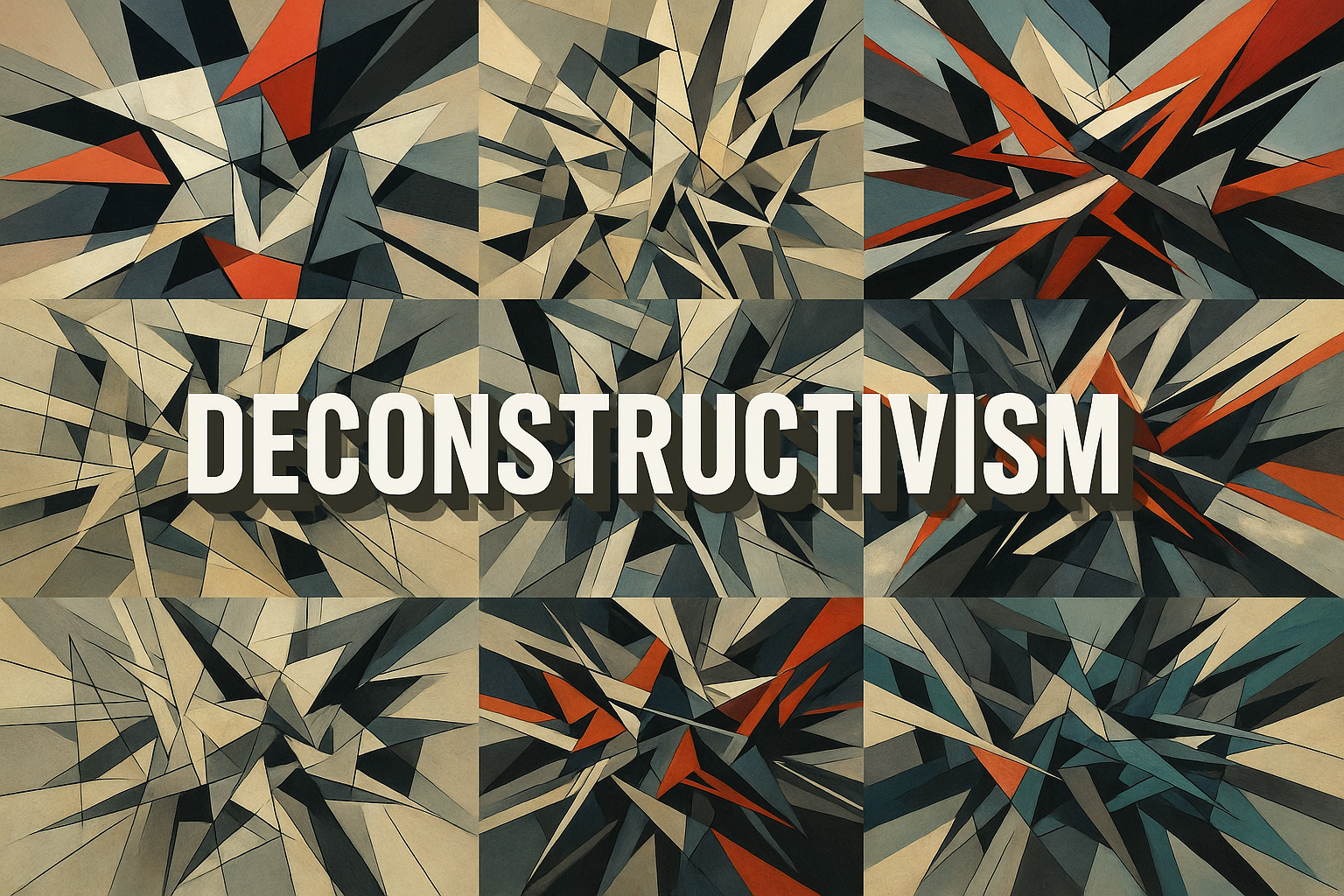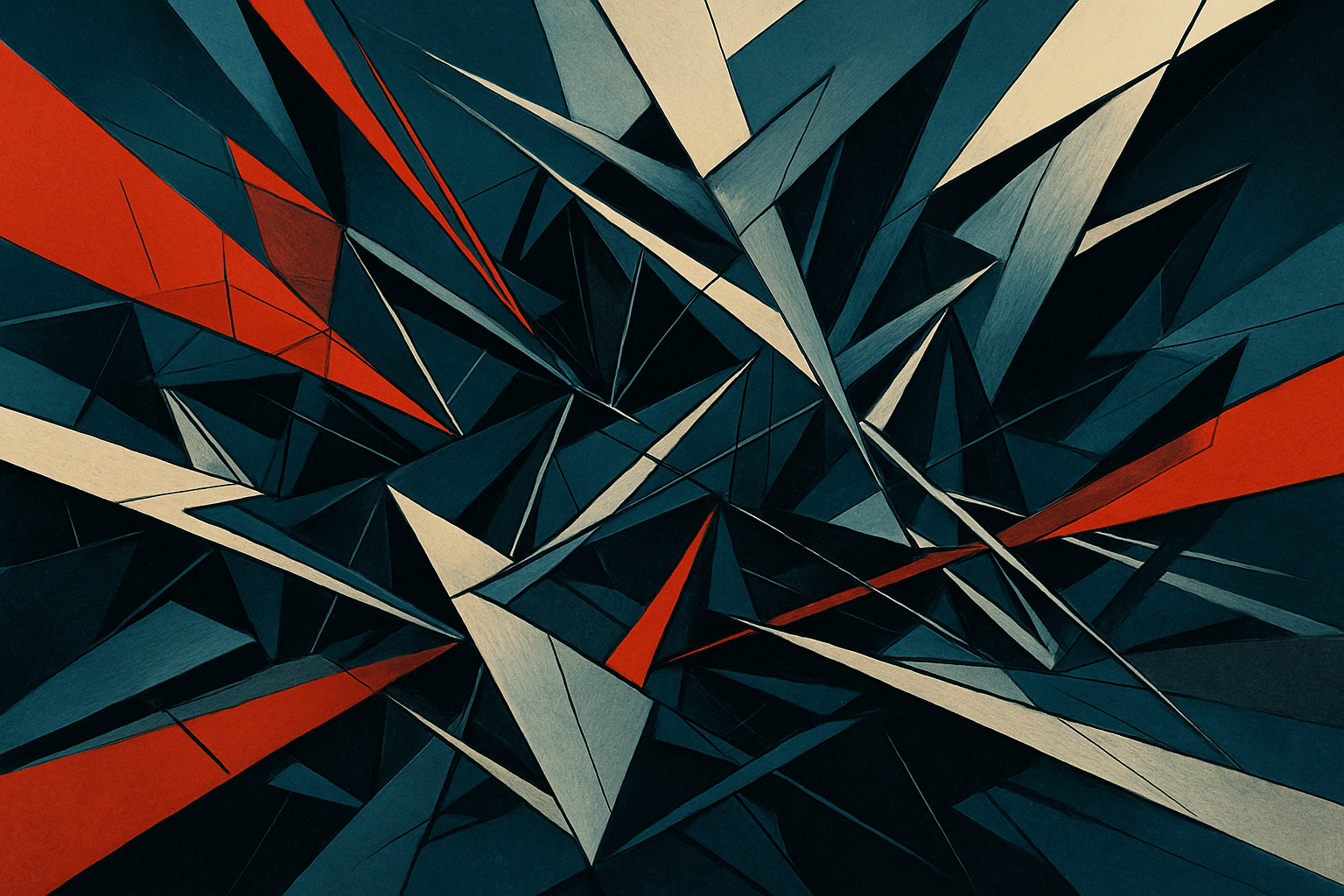
Deconstructivism
Deconstructivism is a visual appearance characterized by the fragmentation of forms. It is often associated with postmodernism and is often used to challenge traditional ideas about form and structure.
AOI thinking about Deconstructivism [+_~]-/
Overview and Quickfacts
Deconstructivism is a movement of postmodern architecture that appeared in the 1980s. It is characterized by an absence of harmony, continuity, or order in the construction of buildings and other structures.
Can understand it also, as:
Tear down, break up, dismantle, disassemble
Categorize it as:
Impressionism, Modernism
.: Dreaming :.
holds a HAIKU for the art style
:. Thought is power .:
Detailed Description
Deconstructivism is a movement of postmodern architecture that appeared in the 1980s. It is characterized by an absence of harmony, continuity, or order in the construction of buildings and other structures. The term “deconstruction” was first coined by French philosopher Jacques Derrida in the 1960s. Deconstructivism has its roots in the philosophy of Jacques Derrida, who argued that all meaning is derived from the structure of language, and that meaning is always deferred or postponed. This philosophy was later applied to architecture by Peter Eisenman, who sought to create buildings that would deconstruct themselves. Eisenman’s most famous project is the Wexner Center for the Arts, which was completed in 1989. The building is composed of two rectangular volumes that are rotated with respect to each other. This creates a sense of instability and disorientation. Other notable deconstructivist architects include Frank Gehry, Zaha Hadid, and Rem Koolhaas. Deconstructivist architecture has also been influenced by the work of Russian Constructivist architects such as Vladimir Tatlin and El Lissitzky.
.. beep, beep, beep ..
<START OF TRANSMISSION>
1. Deconstructivism is a movement of postmodern architecture which appeared in the 1980s. 2. It is characterized by an absence of preconceived structure, by the use of fragmented forms and by the rejection of harmony and symmetry. 3. The deconstructivist architects were influenced by the ideas of the French philosopher Jacques Derrida. 4. Deconstructivism is often associated with deconstruction, a philosophical movement developed by Derrida. 5. The deconstructivist architects rejected the traditional rules of architecture, such as the rules of perspective and proportion. 6. They sought to create buildings which were expressive and which would provoke reaction in the viewer. 7. The deconstructivist movement was short-lived, lasting only a few years in the early 1990s. 8. Some of the most famous deconstructivist architects include Frank Gehry, Zaha Hadid, Rem Koolhaas, Daniel Libeskind and Peter Eisenman. 9. The Guggenheim Museum in Bilbao, Spain, designed by Frank Gehry, is one of the most famous examples of deconstructivist architecture. 10. The Jewish Museum in Berlin, designed by Daniel Libeskind, is another well-known deconstructivist building. 11. The deconstructivist style is often criticized for being difficult to understand and for being ugly. 12. Some people have also criticized deconstructivist architecture for being too expensive to build. 13. Deconstructivism has been described as "the architecture of uncertainty". 14. It is sometimes also referred to as "the architecture of confusion". 15. Deconstructivism is not a style in the traditional sense of the word. 16. It is more of an approach or an attitude. 17. Deconstructivist architects often use unusual materials and forms. 18. They also often make use of different scales in their buildings. 19. Deconstructivism is sometimes seen as a reaction against the modernist movement. 20. Some people see it as a continuation of the modernist tradition.
<EOF>
.. robbel bob
Visual Examples from our image gallery
Coming soon, we are so slow .. might never come
Artists, Paintings, and more
(be aware, can be highly speculative)
Artists (be aware, speculation possible):
1. Frank Gehry (1929-present) 2. Daniel Libeskind (1946-present) 3. Peter Eisenman (1932-present) 4. Zaha Hadid (1950-2016) 5. Rem Koolhaas (1944-present) 6. Bernard Tschumi (1944-present) 7. Lebbeus Woods (1940-2012) 8. Maya Lin (1959-present) 9. Elizabeth Diller (1954-present) 10. Ricardo Scofidio (1935-present) 11. Diller Scofidio + Renfro (est. 1979) 12. Greg Lynn (1964-present) 13. Hani Rashid (1961-present) 14. Lise Anne Couture (1964-present) 15. Ben van Berkel (1957-present) 16. Caroline Bos (1961-present) 17. John Hejduk (1929-2000) 18. Michael Graves (1934-2015) 19. Stanley Tigerman (1930-2019) 20. Cesar Pelli (1926-2019) 21. James Ingo Freed (1930-2005) 22. Thom Mayne (1944-present) 23. Peter Cook (1934-present) 24. Coop Himmelb(l)au (est. 1968) 25. Neil Denari (1958-present) 26. Greg Lynn FORM (est. 1993) 27. MVRDV (est. 1991) 28. OMA (est. 1975) 29. AMO (est. 1991) 30. DFA (est. 1997)
Artworks (be aware, speculation possible)
1. “Naked City” by Kiki Smith (1992) 2. “The Garden of Earthly Delights” by Hieronymus Bosch (1490-1510) 3. “The Persistence of Memory” by Salvador Dali (1931) 4. “The Scream” by Edvard Munch (1893) 5. “Guernica” by Pablo Picasso (1937) 6. “The Cabinet of Dr. Caligari” by Robert Wiene (1920) 7. “Nighthawks” by Edward Hopper (1942) 8. “American Gothic” by Grant Wood (1930) 9. “The Birth of Venus” by Sandro Botticelli (1486) 10. “The Last Supper” by Leonardo da Vinci (1498) 11. “The Starry Night” by Vincent van Gogh (1889) 12. “The Hay Wagon” by Andrew Wyeth (1965) 13. “The Madonna and Child” by Michelangelo (1497) 14. “The Mona Lisa” by Leonardo da Vinci (1503-1517) 15. “The Night Watch” by Rembrandt (1642) 16. “The Sistine Chapel Ceiling” by Michelangelo (1508-1512) 17. “The Battle of San Romano” by Paolo Uccello (1438-1440) 18. “The Arnolfini Portrait” by Jan van Eyck (1434) 19. “The Ghent Altarpiece” by Jan and Hubert van Eyck (1432) 20. “The Portrait of Giovanni Arnolfini and His Wife” by Jan van Eyck (1434) 21. “The Marriage of Giovanni Arnolfini” by Jan van Eyck (1434) 22. “The Annunciation” by Leonardo da Vinci (1472-1475) 23. “The Baptism of Christ” by Leonardo da Vinci (1472-1475) 24. “The Adoration of the Magi” by Leonardo da Vinci (1481-1482) 25. “The Virgin of the Rocks” by Leonardo da Vinci (1483-1486) 26. “The Last Judgment” by Michelangelo (1536-1541) 27. “The Creation of Adam” by Michelangelo (1512) 28. “The Fall of Adam and Eve” by Michelangelo (1512) 29. “The Deluge” by Michelangelo (1512) 30. “The Flood” by Michelangelo (1512)
Epoch
The time period of Deconstructivism is generally considered to be the late 1980s and early 1990s.
AI ART RESSOURCES (AKA, well Tools)
Helping tools -> predefined search links on other pages:











